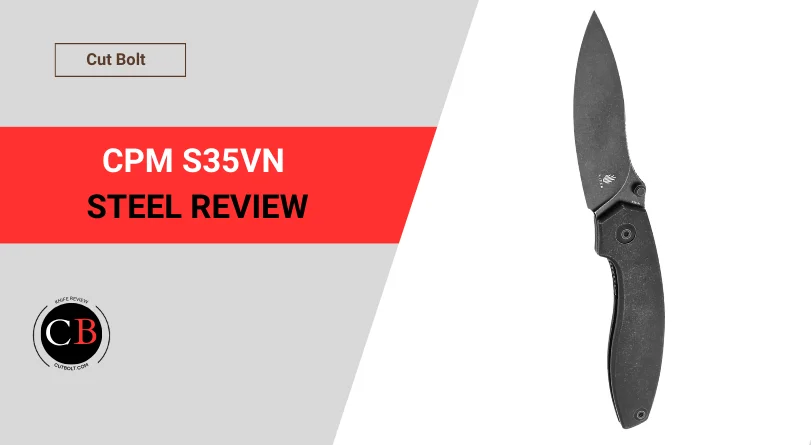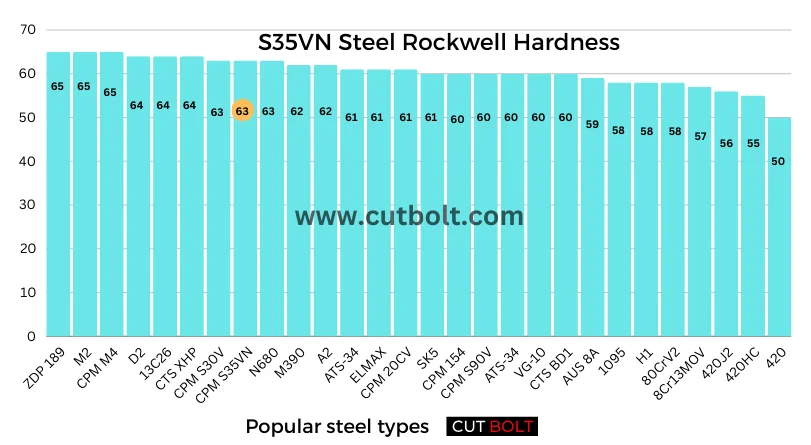When Crucible Industries introduced its CPM S30V steel, bladesmiths and knife enthusiasts alike fell in love with it. The quality of the steel’s wear resistance, toughness and machinability was unparalleled. People referred to it as “the best knife steel,” and indeed, it may have been.
Until Crucible Industries announced that they were launching a newer, improved version of their highest-quality knife steel: CPM S35VN. Important question! Is S35VN steel good for knives?
Compared to its predecessor, CPM S30V, it has greater toughness and ease of sharpening. It soon became clear that CPM S35VN steel was a premium steel that could compete with the best in its class.
Table of Contents
What is CPM S35VN steel and how does it differ from S30V?
CPM-S35VN is a high-quality, martensitic, stainless steel from Crucible. It is a part of Crucible Industries’ “SxxV Series”. “CPM” identifies the steel as being produced by Crucible Industries’ CPM process and provides a better result than conventional melting processes. The letters “S,” “V” and “N” refer to the terms “stainless,” “vanadium” and “niobium,” respectively. However, the number 35 is used only to distinguish it from CPM S30V.
S35VN steel consists of 1.4 percent carbon, 14 percent chromium, 3 percent vanadium, 2 percent molybdenum and 0.5 percent niobium.
Carbon is the most important element for the hardness of steel. The higher the carbon content, the harder the steel. When combined with other alloys such as chromium and vanadium, carbides are formed that are harder than carbon alone. The carbon content of CPM S35VN is similar to S30V, which contains 1.45 percent carbon. See the datasheet of S35VN steel.

Niobium and vanadium in S35VN steel
A bit of carbide called niobium was introduced in S35VN at the expense of the steel’s vanadium content. It’s an innovative and crucial change that sets the S35VN steel apart from its predecessor and many other steels. The niobium makes CPM S35VN steel 15 to 20 percent harder than S30V.
Despite the high toughness of this steel, which typically reduces a steel’s wear resistance, S35VN does not lose any of its superior wear and chip resistance.
When combined with carbon, the niobium carbides make the steel more effective against wear and edge chipping, which rely more heavily on chromium, which is the case with many other steels. The resulting edge retention of this steel is remarkable and ensures that S35VN steel will last a long time.
Chromium and Molybdenum
Vanadium is also essential in balancing the toughness of S35VN with its wear resistance. It not only increases strength and toughness, but also promotes fine grain structure and forms hard carbides that dramatically increase edge retention.
Molybdenum is another important ingredient for the wear resistance of this steel because the harder the steel, the stiffer it becomes.
Molybdenum combines with carbon to form hard carbides which eliminate this problem. For these reasons, S35VN steel offers superior edge retention over conventional high chromium steels such as 440C and D2.
Although the carbide contains less chromium, it is still critical to the high quality of the steel. Chromium is a critical ingredient to increase the stain resistance of a steel. And although it is not on par with niobium and vanadium in terms of wear resistance, chromium still contributes significantly to increasing the wear resistance of a steel and is therefore still as important as the other components of S35VN.
This composition makes CPM S35VN steel a very hard, high-quality steel that has excellent dimensional stability, excellent grindability and toughness, making it a top-quality steel.
Carbide type and volume in steels like S35VN
| Steel Name | Vanadium | Niobium | Chromium | Total |
|---|---|---|---|---|
| CPM S35VN | 3.00% | 0.50% | 10.50% | 14.00% |
| CPM S30V | 4.00% | 10.50% | 14.50% | |
| 440C | 0% | 12.00% | 12.00% | |
| 154 CM | 0% | 17.50% | 17.50% | |
| CPM S90V | 9.00% | 11.00% | 20.00% |

Test and compare CPM S35VN steel
Charpy notched bar impact test
Fracture and deformation tests are carried out using the two variants of the so-called Charpy notched impact test. In the “V-notch test”, longitudinal toughness is measured – the impact pendulum strikes the center of the test specimen, which is supported on two sides, at the level of the notch. In the “C-notch test”, the specimen is on edge and the pendulum strikes the free end of the specimen above the notch. The C-notch test measures the transverse resistance.
The Charpy V-notch test measures the torque required to break specimens of certain steels at certain temperatures and given hardness. At a Rockwell hardness of 58, 43 Nm was required to break the S35VN specimen. This is higher than all other steels tested, including CPM S30V (at 58 HRC), S60V (at 56 HRC), S90V (at 58HRC) and 154 (at 60HRC), 420HC (at 58 HRC) and M390 (at 60 HRC).
The C-notch test showed that CPM steels – both S35VN and S30V – are far superior to the other knife steels tested. S35VN holds a transverse resistance of up to 16 Nm, while S30V is two pounds at 13.5 Nm.
The other steels tested, 145CM and 440C grade steels, scored nearly 5 times less than S35VN, both at only 3.8 Nm of resistance. These results indicate that the CPM steels are much more resistant to chipping and fracture in work requiring lateral loading. This makes these steels particularly good for use in larger blades.
CATRA Test for S35VN
The results of a CATRA (Cutlery Allied Trades Research Association) test for cut resistance ranked this steel on par with other premium steels such as Bohler M390 and N690, Uddenholm ELMAX and Peachey A2 at Rockwell hardnesses.
In the CATRA TCC (Total Cut Cards) test, which measures the number of cards impregnated with silicone, S35VN scored 707, which is higher than many steels, including N690, A2 and 3V, though there are steels that score above, such as ELMAX and M390.
In addition to the tests, the S35VN steel used in various knives has won numerous awards.
The test results and awards for S35VN and the knives equipped with it confirm that S35VN is of the quality claimed, or at least give the claims some validity.

Related: Uddeholm Sleipner steel review
S35VN vs Other steels
We have made a comparison between similar steel that can compete with S35VN knife steel:
S35VN steel vs. CPM 154
CPM 154 steel is a stainless steel with high chromium content. It excels in hardness, corrosion resistance and edge retention over other steels such as 440C and D2.
Manufactured using Crucible Industries’ CPM process, it offers even better toughness, machinability and tool performance. However, compared to CPM S35VN steel, the results are less impressive.
S35VN is more advanced steel with vanadium and niobium carbides to improve its toughness and wear resistance. The simpler 154 steel is composed of only carbon, molybdenum and chromium, and therefore cannot offer the same level of toughness and wear resistance as these innovative carbides.
For these reasons, knives made from CPM 154 or 154 CM steel are not as expensive as those made from CPM S35VN steel.
S35VN steel vs ELMAX
There has been a lot of buzz lately about ELMAX steel. The claims that it is a superior “super steel” are more than true, as ELMAX steel continues to impress all who use it.
Many of its users will say that ELMAX is far superior to S35VN. ELMAX has a sophisticated composition that includes carbon, chromium, manganese, molybdenum, silicon and vanadium. This composition provides very high wear and corrosion resistance, hardness and remarkable dimensional stability.
ELMAX does not contain niobium, the key ingredient in S35VN, but exhibits superior reliability to S35VN at a high HRC, as well as higher corrosion resistance while maintaining toughness.
ELMAX is produced using a particle metallurgy process similar to Crucible Industries’ CPM process. Many will argue that CPM provides better results and gives the steels a cutting edge with improved wear resistance and grindability.
Powder metallurgy and other conventional steelmaking processes tend to segregate where uneven clusters of carbides remain as remnants of the microstructure in the as-cast structure. This separation of alloys can have a negative impact on the production and performance of the steel.
However, the CPM process creates an even distribution of carbide clusters and completely eliminates the risk of segregation.
Knives containing these two steels are far from inexpensive, with folding knife prices ranging from 130-200 EUR and more.
Bohler M390 vs CPM S35VN steel
Bohler’s M390 is not very different from ELMAX. It is extremely corrosion-resistant, very fine-grained and very pure. Like ELMAX, it is as tough if not tougher than S35VN and extremely sharp. In the CATRA TCC test, M390 scored 959, higher than S35VN’s 707. However, in the Charpy-C notched impact test, S35VN resisted with an impressive 43.3 Nm (M390: 29.8 Nm). Welders may find that M390 is much harder to temper than S35VN, which can affect machinability.
M390 steel is also slightly more expensive than S35VN, with the price of an average folding knife being around 200 dollars, while a good S35VN folding knife can be had for as little as 120 dollars.
Conclusion: Is S35VN steel good for knives
Many high-end knife manufacturers use CPM-S35VN. The list includes renowned manufacturers like Benchmade, Chris Reeve Knives, Spyderco, ProTech Knives and Böker, to name a few.
Whether you want to buy or make a knife with CPM S35VN steel, it is obvious that this steel is of the highest quality.
Its toughness, wear resistance, and machinability are surpassed by few – and then not without drawbacks. With this combination of properties, it provides a pleasant and outstanding experience for both the knife maker and the knife user and enthusiast.



